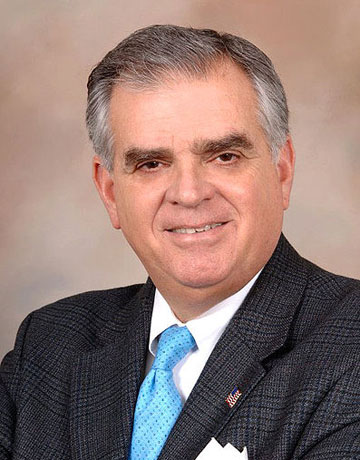The other shoe has dropped: Yesterday, two U.S. government agencies jointly announced the final fuel-economy rules for model year 2012 through 2016 vehicles, giving automakers a single national set of standards and averting the threat of state-by-state regulation.
Starting with 2012, automakers must improve the fleet average fuel economy of their light-duty vehicles (cars, crossovers, SUVs, light vans, and pickup trucks) by roughly 5 percent each year, reducing tailpipe emissions of greenhouse gases by 5 percent at the same time.

U.S. Environmental Protection Agency adminstrator Lisa Jackson and President Barack Obama

Ray LaHood

Transportation Secretary Ray LaHood, a Republican member of the Cabinet, feigns being a blocking back for President Barack Obama as he arrives backstage to meet with GOP House leaders before speaking to their issues conference at the Renaissance Baltimore Harbor Place Hotel in Baltimore, Md., Jan. 29, 2010. (Official White House Photo by Pete Souza; http://www.flickr.com/photos/whitehouse)

A state-by-state emissions framework could prove prohibitively costly to automakers

2016 average: 34.1 MPG
Across the entire industry, the combined light-vehicle fleet average will reach approximately 34.1 miles per gallon.
Different sizes and classes of models must meet different standards, e.g. pickup trucks have lower mileage requirements than subcompacts.
DoT + EPA/NHTSA, GHGs, CO2
The standards were jointly issued by the U.S. Department of Transportation (DOT) and the U.S. Environmental Protection Agency (EPA).
The DoT, through its National Highway Traffic Safety Administration (NHTSA), is responsible for setting Corporate Average Fuel Economy (CAFE) gas-mileage standards. The EPA regulates tailpipe emissions including greenhouse gases, primarily carbon dioxide (CO2), under the Clean Air Act.
Significantly, Canada announced similar light-duty vehicle emissions regulations yesterday as well, meaning common regulations across North America. The EPA and NHTSA "worked closely" with Environment Canada to ensure similar rules for both countries.
Because CO2 produced is almost directly proportional to fuel consumed, the EPA mandate to regulate its emissions from vehicles meant it was indirectly setting mileage standards.
California leads
Initial limits had been set by the state of California, raising the spectre of separate national standards automakers would have to meet.
After the Obama Administration took office in January 2009, it brought the two agencies and the automakers together to craft a single national standard supported by all parties.
The new regulations finalize a proposal first issued last September, which received a remarkable 130,000 comments from the public.
The announcement fulfilled a promise to provide a single standard to U.S. auto producers, with enough notice that they can make capital commitments to tool up for future fuel-efficient vehicles.
Higher cost but $3K lifetime savings?
In a press release, the EPA said the new regulations would save the "average buyer" of a 2016 car "$3,000 over the life of the vehicle," even though that vehicle may cost more initially due to higher-technology engines, transmissions, and other equipment.
The standards will also cut CO2 emissions by almost 1 billion metric tons of the lifetime of the 2012-2016 vehicles, and conserve about 1.8 billion barrels of oil over the same period.
Smaller, more efficient engines
Automakers will use a variety of methods to meet the standards, including smaller, more efficient engines with direct injection and/or turbochargers; more sophisticated automatic and dual-clutch transmissions (DCTs); hybrid-electric systems; and clean diesel engines.
The bulk of the gains will come from "more widespread adoption of conventional technologies" already in use, which also include tires with lower rolling resistance, more aerodynamic vehicles, and lighter-weight materials.
Manufacturers can gain additional EPA credits for improvements to the efficiency of auto air-conditioning systems, but those do not apply to meeting the CAFE requirements. Hence the EPA standard is slightly stricter--the equivalent of 35.5 mpg--so that it has the same limits as NHTSA once those credits are granted.
Only a small percentage of the improvements by 2016 will come from pure electric vehicles (e.g. 2011 Nissan Leaf) and plug-in hybrid vehicles (e.g. 2011 Chevrolet Volt or 2012 Toyota Prius Plug-In Hybrid). They are expected to have more impact by 2020 and after.
"Win" for all
EPA administrator Lisa Jackson said the new standards were "an important example of how our economic and environmental priorities go hand-in-hand," saying they were "a win" for automakers and drivers, for innovators and entrepreneurs, and for the planet.
Transportation secretary Ray LaHood called the new fuel-economy requirements were "ambitious, but achievable."
[EPA]













